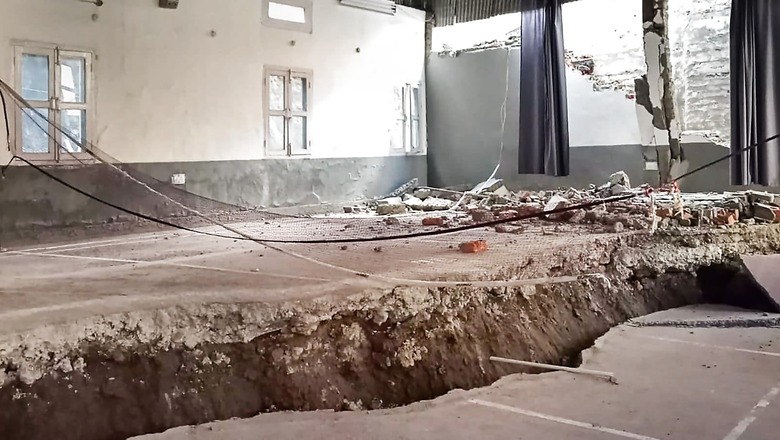
views
Days after Uttarakhand’s Joshimath was declared a landslide-subsidence zone, some geologists have said that the town is “sinking” technically due to “sliding” not “subsidence”.
Kalachand Sain, Director, Wadia Institute of Himalayan Geology (WIHG) said the phenomenon in Joshimath cannot be called subsidence in geological terms and asserted that what’s happening in the town is an instance of the surface sliding down.
He also gave some reasons to back his claim. “One, the foundation rocks are some crystalline rocks and here are several structures built on them and an entire habitation is settled. Two, Joshimath is situated between two important tectonic faults—the Munsiyari thrust to the south and the Vaikrita thrust to the north which have a thrusting influence. It is a kind of a shear zone so the rocks are relatively weak in strength. Very long back, some 6,000 years ago there were some landslides possibly linked to earthquakes in this zone. It is a very seismically active area.”
“Three, in February 2021 there was the Rishiganga deluge linked to a glacier breach which led to a flow of debris in Alaknanda and erosion in several regions and toes were formed. It also contributed to the weakness in the region. Four, was there water seepage from a source? Lubrication may have triggered it. The linkage with construction of hydropower plant etc need to be ascertained with certainty through geophysical imaging which is a critical matter of study immediately. Such rapid sliding is seen when there is lubrication or water flow,” Sain was quoted as saying by Hindustan Times.
A geologist associated with Geological Survey of India who did not wish to be named said it appears that there has been an aquifer burst because there is flow of water from under the surface. “But without enough evidence it cannot be said what has caused it. This is why investigations are critical at this stage to fix accountability. Once subsidence starts it can occur over several months and we know that this sliding also started months back but now it has picked pace. The entire region may be impacted due to this.”
Professor Y P Sundriyal, Head of Department, Geology, HNB Garhwal University said the ongoing crisis in Joshimath is primarily because of anthropogenic activities.
“The population has increased manifold and so has the tourist landfall. Infrastructure has also amplified and has been unchecked. However, the town does not have a proper drainage system. Besides gradual weathering of fine material between the rocks of debris, water percolation has decreased the cohesive strength of the rocks over the time. This has resulted in landslides, triggering cracks in the houses. Secondly, construction of these tunnels for hydro power projects is being done through blasting, creating local earthquake tremors, shaking debris above the rocks, again leading to the cracks. Government has not learnt anything from the 2013 Kedarnath floods and 2021 Rishi Ganga flash flooding,” he said.
Uttarakhand Chief Minister Pushkar Singh Dhami has said his government is moving step by step to address the issues of subsidence-hit Joshimath town in Chamoli district.
“Our biggest priority now is to provide quick relief to the affected people and evacuate them to safety. The affected families are being shifted to safer places. The demarcation of the affected buildings is going on continuously. Teams of geologists and experts are engaged in investigating the causes of land subsidence in the town,” the chief minister added.
A total of 169 families living in the town have so far been shifted to relief centres after Joshimath was declared a landslide-subsidence zone.
ALSO READ: In the Same Boat: Not Just Joshimath, These U’khand Towns Also at Risk of ‘Sinking’, Says Report
Not Just Joshimath, These U’khand Towns Also at Risk of ‘Sinking’: Report
Joshimath is not the only town in the ecologically fragile Himalayan region at risk of subsidence. “The villages and townships in the northern part of Uttarakhand are located along the major active thrust zones within the Himalayas and are very sensitive because of the fragile ecosystem of the region,” said Rajeev Upadhyay, professor of geology at the Kumaun University in Nainital, told Bloomberg.
“Many habitations, which are built on the debris of old landslides, are already under natural stress and man-made constructions are adding further stress to the region,” he said. “If you do a lot of excessive mechanical activities in the region, the land will be prone to slide. The whole area is vulnerable to subsidence.”
There are currently four hydropower projects with a combined projected cost of about 155 billion rupees under construction in Uttarakhand, as per the Bloomberg report. Apart from Joshimath, several other towns in the region are at risk including Tehri, Mana, Dharasu, Harshil, Gauchar and Pithoragarh.
ALSO READ: ‘Sinking’ Hill Towns: Amid Panic in Joshimath, Experts Say Uttarkashi & Nainital Under Threat As Well
WHAT IS LAND SUBSIDENCE?
Subsidence is ground sinking. It is caused by underground material movement, but is most commonly caused by the removal of water, oil, natural gas, or mineral resources from the ground through pumping, fracking, or mining activities.
Natural events such as earthquakes, soil compaction, glacial isostatic adjustment, erosion, sinkhole formation, and adding water to fine soils deposited by wind can also cause subsidence (a natural process known as loess deposits), explains a report by the National Oceanic and Atmospheric Administration (US).
Subsidence can occur over very large areas, such as entire states or provinces, or over very small areas, such as a corner of your yard.
WHAT IS THE MOST COMMON CAUSE OF LAND SUBSIDENCE?
Compaction of soils in some aquifer systems can occur as a result of excessive groundwater pumping, and it is by far the most common cause of subsidence, the report by USGS says.
Excessive pumping of these aquifer systems has caused permanent subsidence and ground failures. When large amounts of water are pumped into some systems, the subsoil compacts, reducing the size and number of open pore spaces in the soil that previously held water. This can result in a permanent reduction in the aquifer system’s total storage capacity.
Read all the Latest India News here




















Comments
0 comment